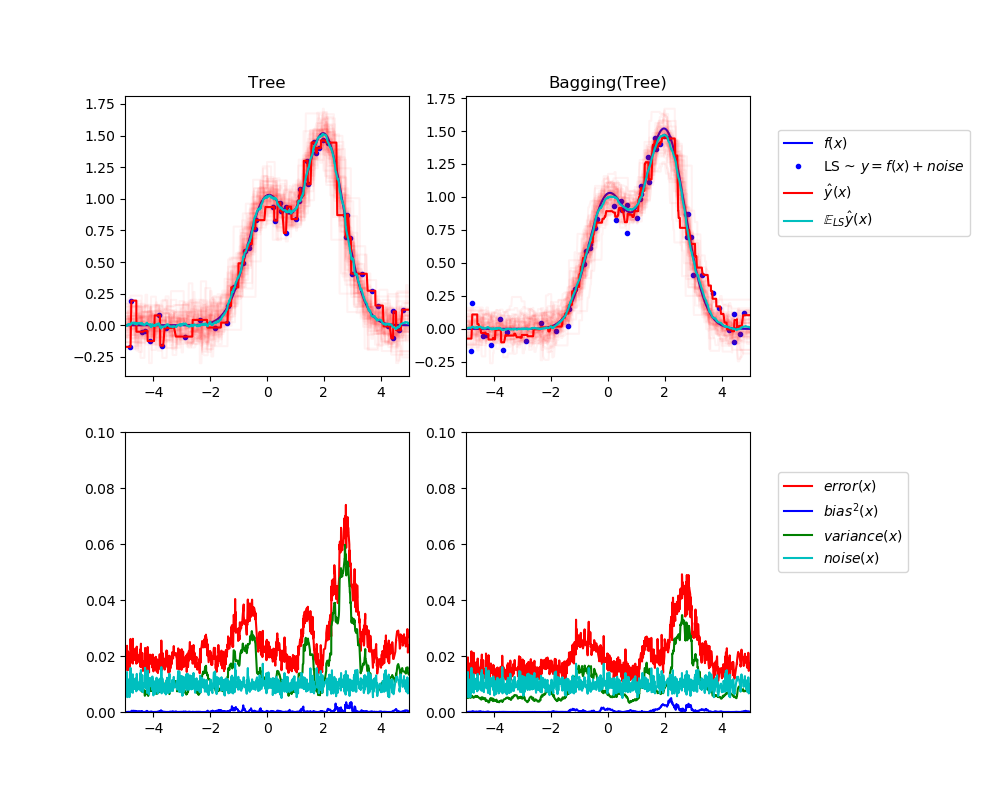sklearn.ensemble.BaggingRegressor?
class sklearn.ensemble.BaggingRegressor(base_estimator=None, n_estimators=10, *, max_samples=1.0, max_features=1.0, bootstrap=True, bootstrap_features=False, oob_score=False, warm_start=False, n_jobs=None, random_state=None, verbose=0)
Bagging分類器。
Bagging分類器是一個集合元估計器,它使每個基本分類器擬合原始數據集的隨機子集,然后將其單個預測(通過投票或平均)進行匯總以形成最終預測。這類元估計器通過將隨機化引入其構造過程中,并對其進行整體化,來減少黑盒估計器(例如決策樹)方差。
該算法涵蓋了文獻中的幾篇著作。當將數據集的隨機子集繪制為樣本的隨機子集時,該算法稱為Pasting[1]。如果抽取樣本進行替換,則該方法稱為Bagging [2]。當將數據集的隨機子集繪制為要素的隨機子集時,該方法稱為Random Subspaces[3]。最后,當基于樣本和特征的子集建立基本估計器時,該方法稱為Random Patches[4]。
在用戶指南中閱讀更多內容。
0.15版的新功能。
| 參數 | 說明 |
|---|---|
| base_estimator | object, default=None 基本估計器適合數據集的隨機子集。如果為None,則基本估計器為決策樹。 |
| n_estimators | int,default = 10 集合中基本估計器的數量。 |
| max_samples | int or float, default=1.0 從X抽取以訓練每個基本估計器的樣本數量(默認情況下 bootstrap為替換,請參見有關更多詳細信息)。- 如果為int,則抽取 max_samples樣本。- 如果為float,則抽取樣品。 max_samples * X.shape[0]。 |
| max_features | int or float, default=1.0 從X繪制以訓練每個基本估計器的要素數量(默認情況下不進行替換, bootstrap_features有關更多詳細信息,請參見)。- 如果為int,則繪制 max_features特征。- 如果為float,則繪制特征。 max_features * X.shape[1] |
| bootstrap | bool, default=True 是否抽取樣本進行替換。如果為False,則執行不替換的采樣。 |
| bootstrap_features | bool, default=False 是否用替換繪制特征。 |
| oob_score | bool,defalut = False 是否使用現成的樣本來估計泛化誤差。 |
| warm_start | bool,defalut = False 設置為True時,請重用上一個調用的解決方案以適合并在集合中添加更多估計器,否則,僅適合一個全新的集合。請參閱Glossary。 0.17版中的新功能: warm_start構造函數參數。 |
| n_jobs | int, default=Nonefit和 并行運行的作業數predict。除非用于joblib.parallel_backend上下文中,否則None表示1 。-1表示使用所有處理器。有關更多詳細信息,請參見Glossary。 |
| random_state | int or RandomState, default=None 控制原始數據集的隨機重采樣(sample wise 和 feature wise)。如果基本估算器接受 random_state屬性,則會為集合中的每個實例生成一個不同的種子。為多個函數調用傳遞可重復輸出的int值。請參閱Glossary。 |
| verbose | int, default=0 在擬合和預測時控制冗余程度。 |
| 屬性 | 說明 |
|---|---|
| base_estimator_ | estimator 通過集成成長而來的基本估計器。 |
| n_features_ | intfit執行時的功能數量。 |
| estimators_ | list of estimators 擬合基礎估計器的集合。 |
| estimators_samples_ | list of arrays 每個基本估計器的抽取樣本的子集。 |
| estimators_features_ | list of arrays 每個基本估計器的繪制要素子集。 |
| classes_ | ndarray of shape (n_classes,) 類標簽。 |
| n_classes_ | int or list 類數。 |
| oob_score_ | float 使用"袋外"估計獲得的訓練數據集的分數。該屬性僅在 oob_score為True 時存在。 |
| oob_decision_function_ | ndarray of shape (n_samples, n_classes) 用訓練集上的實際估計值計算的決策函數。如果 n_estimators較小,則有可能在bootstrap過程中不會遺漏任何數據點。在這種情況下, oob_decision_function_可能包含NaN。該屬性僅在oob_score為True 時存在。 |
參考文獻:
[1] L. Breiman, “Pasting small votes for classification in large databases and on-line”, Machine Learning, 36(1), 85-103, 1999.
[2] L. Breiman, “Bagging predictors”, Machine Learning, 24(2), 123-140, 1996.
[3] T. Ho, “The random subspace method for constructing decision forests”, Pattern Analysis and Machine Intelligence, 20(8), 832-844, 1998.
[4] G. Louppe and P. Geurts, “Ensembles on Random Patches”, Machine Learning and Knowledge Discovery in Databases, 346-361, 2012.
實例:
>>> from sklearn.svm import SVR
>>> from sklearn.ensemble import BaggingRegressor
>>> from sklearn.datasets import make_regression
>>> X, y = make_regression(n_samples=100, n_features=4,
... n_informative=2, n_targets=1,
... random_state=0, shuffle=False)
>>> regr = BaggingRegressor(base_estimator=SVR(),
... n_estimators=10, random_state=0).fit(X, y)
>>> regr.predict([[0, 0, 0, 0]])
array([-2.8720...])
方法
| 方法 | 說明 |
|---|---|
fit(X, y[, sample_weight]) |
從訓練集中構建一個bagging評估器的集合。 |
get_params([deep]) |
獲取此估計器的參數。 |
predict(X) |
預測X的回歸目標。 |
score(X, y[, sample_weight]) |
返回預測的決定系數R^2。 |
set_params(**params) |
設置此估算器的參數。 |
__init__(base_estimator=None, n_estimators=10, *, max_samples=1.0, max_features=1.0, bootstrap=True, bootstrap_features=False, oob_score=False, warm_start=False, n_jobs=None, random_state=None, verbose=0)
初始化self。有關準確的簽名,請參見help(type(self))。
property estimators_samples_
每個基本估計器的抽取樣本的子集。
返回一個動態生成的索引列表,這些索引標識用于擬合集合的每個成員的樣本,即袋裝樣本。
注意:在每次調用屬性時都會重新創建列表,以通過不存儲采樣數據來減少對象內存占用。因此,獲取屬性可能比預期要慢。
fit(X, y, sample_weight=None)
從訓練集中構建一個bagging評估器的集合。
set(X, y)
| 參數 | 說明 |
|---|---|
| X | {array-like, sparse matrix} of shape (n_samples, n_features) 訓練輸入樣本。僅當基本估計器支持稀疏矩陣時,才接受。 |
| y | array-like of shape (n_samples,) 目標值(分類中的類標簽,回歸中的實數)。 |
| sample_weight | array-like of shape (n_samples,), default=None 樣品重量。如果為None,則對樣本進行平均加權。請注意,僅當基本估算器支持樣本加權時才支持此功能。 |
| 返回值 | 說明 |
|---|---|
| self | object |
get_params(deep=True)
獲取此估計器的參數。
| 參數 | 說明 |
|---|---|
| deep | bool, default=True 如果為True,則將返回此估算器和作為估算器的所包含子對象的參數。 |
| 返回值 | 說明 |
|---|---|
| params | mapping of string to any 參數名稱與其值相對應。 |
predict(X)
返回預測的決定系數R^2。
計算輸入樣本的預測回歸目標作為集成估計量的平均預測回歸目標。
| 參數 | 說明 |
|---|---|
| X | {array-like, sparse matrix} of shape (n_samples, n_features) 訓練輸入樣本。僅當基本估計器支持稀疏矩陣時,才接受。 |
| 返回值 | 說明 |
|---|---|
| y | ndarray of shape (n_samples,) 被預測的類。 |
score(X, y, sample_weight=None)
返回預測的決定系數R^2。
決定系數R^2為(1 - u/v),其中u為((y_true - y_pred) ** 2).sum()的殘差平方和,v為(y_true - y_true.mean()) ** 2).sum()的平方和。最好的可能的分數是1.0,它可能是負的(因為模型可以任意地更糟)。常數模型總是預測y的期望值,而不考慮輸入特征,得到的R^2得分為0.0。
| 參數 | 說明 |
|---|---|
| X | array-like of shape (n_samples, n_features) 測試樣本。對于一些估計器,這可能會被一個預先計算的內核矩陣或一列通用對象替代,而不是shape= (n_samples, n_samples_fitted),其中n_samples_fitted是用于擬合估計器的樣本數量。 |
| y | array-like of shape (n_samples, ) or (n_samples, n_outputs) X的正確值。 |
| sample_weight | array-like of shape (n_sample, ), default = None 樣本權重。 |
| 返回值 | 說明 |
|---|---|
| score | float self.predict(X)關于 y的決定系數R^2 |
注意:
調用回歸變器的score時使用的R2 score,與0.23版本的multioutput='uniform_average'中r2_score的默認值保持一致。這影響了所有多輸出回歸的score方法(除了MultiOutputRegressor)。
set_params(**params)
設置該估計器的參數。
該方法適用于簡單估計器和嵌套對象(如pipline)。后者具有形式為<component>_<parameter>的參數,這樣就可以更新嵌套對象的每個組件。
| 參數 | 說明 |
|---|---|
| **params | dict 估計器參數 |
| 返回值 | 說明 |
|---|---|
| self | object 估計實例。 |

